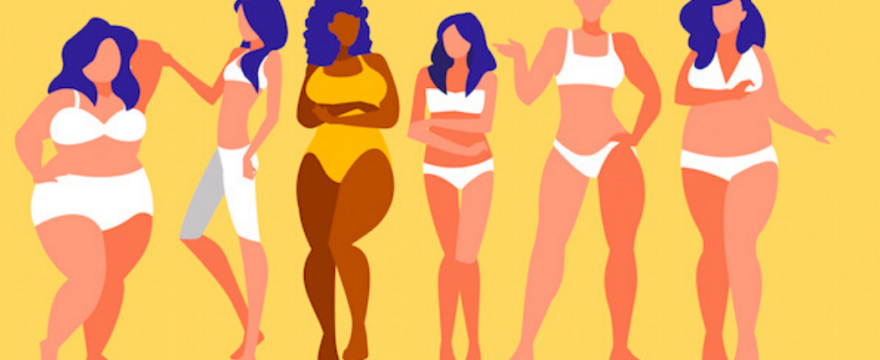Our understanding of body image has grown remarkably over the last 50 years. We now know the causes, consequences, and epidemiology of body image problems, and we’ve even developed novel ways to effectively alleviate body image disturbances.
However, much of the history of body image research is dominated by a focus on pathology that seeks to understand why, how, and for whom negative body image exists. With this has come little consideration of positive body image, including all those adaptive qualities people exhibit towards their body.
It was not until recently did professionals recognize the importance of studying these adaptive qualities as a way to more fully understand the broad construct of body image.
In this article, I want to provide an overview of the positive body image field, including what positive body image means, its distinct components, the evidence base, and how you might cultivate a positive body image.
Table of Contents
What is Positive Body Image?
While we don’t have a concrete definition of positive body image, the most comprehensive definition put forth by Wood-Barcalow et al (2010) is a great starting point 1Wood-Barcalow NL, Tylka TL, Augustus-Horvath CL. “But I like my body”: Positive body image characteristics and a holistic model for young-adult women. Body Image. 2010;7:106-16:
“An overarching love and respect for the body that allows individuals to (a) appreciate the unique beauty of their body and the functions that it performs for them; (b) accept and even admire their body, including those aspects that are inconsistent with idealized images; (c) feel beautiful, comfortable, confident, and happy with their body, which is often reflected as an outer radiance, or a “glow;” (d) emphasize their body’s assets rather than dwell on their imperfections; and (f) interpret incoming information in a body-protective manner whereby most positive information is internalized and most negative information is rejected or reframed”
This definition implies that there are many distinct facets of positive body image that might each work together to create a holistic, favourable impression of the self.
Before diving into these distinct facets, it’s also important to highlight 4 essential facts about positive body image.
Positive body image is different to negative body image
Positive body image is its own construct. It doesn’t simply represent low levels or the absence of negative body image. This means that someone who scores low on negative body image doesn’t necessarily score high on markers of positive body image. To that end, acquiring a positive body image doesn’t simply mean addressing negative body thoughts, feelings and perceptions.
Positive body image is multifaceted
Positive body image is much more than being satisfied with your body image or evaluating your body image favourably. Instead, it involves (1) deep care and appreciation for the body and its functions, (2) pride in its appearance and capabilities, (3) recognition that beauty comes in all shapes and sizes, and (4) caring for the body.
Positive body image is holistic
Even though there are many different facets of positive body image, it is assumed that each facet works together to create a holistic, favourable view of the self.
Positive body image is protective
The facets of positive body image are hypothesized to protect against various illnesses related to physical health and wellbeing. Adopting a positive body image is linked to various health behaviours, enhanced quality of life, stronger interpersonal connections, and lower levels of depression, anxiety and stress 2Tylka TL, Kroon Van Diest AM. The Intuitive Eating Scale–2: Item refinement and psychometric evaluation with college women and men. Journal of Counseling Psychology. 2013;60:137-53.
What are the Distinct Facets of Positive Body Image?
There are many different facets of positive body image that have been widely researched. I want to specifically highlight the 3 most popular facets of positive body image.
Body appreciation
Body appreciation is by far the most widely studied facet of positive body image. It is defined as accepting, holding favourable opinions toward, and respecting the body, while at the same time rejecting media-promoted appearance ideals as the only form of attractiveness.
There have been nearly 500 studies that have investigated the body appreciation construct. Most of these studies have found consistently strong relationships between body appreciation and lower levels of eating disorder symptoms, depression and anxiety, stress, and higher levels of wellbeing. A very recent study also found body appreciation to protect against the onset of many different symptoms of eating disorders at 8-month follow-up 3Linardon J. Positive body image, intuitive eating, and self-compassion protect against the onset of the core symptoms of eating disorders: A prospective study. International Journal of Eating Disorders. 2021.
Body image flexibility
Borne out of acceptance- and mindfulness-based therapies, body image flexibility refers to the tendency for one to openly experience thoughts about the body without acting on them or making efforts to avoid or change them.
Body image flexibility is theorized to be protective because it better helps people cope with negative self-judgements. Therefore, without resorting to harmful eating disorder behaviours like restriction or binge eating whenever you feel bad about yourself, people who practice body image flexibility can acknowledge these negative internal experiences and can continue living in a value-oriented manner.
A recent meta-analysis found that higher levels of body image flexibility was consistently associated with better mental health among a variety of different population groups 4Linardon J, Anderson C, Messer M, Rodgers RF, Fuller-Tyszkiewicz M. Body image flexibility and its correlates: A meta-analysis. Body Image. 2021;37:188-203. Furthermore, low body image flexibility might even prevent people from recovering from an eating disorder during treatment 5Pellizzer ML, Waller G, Wade TD. Predictors of outcome in cognitive behavioural therapy for eating disorders: An exploratory study. Behaviour Research and Therapy. 2019;116:61-8.
Functionality appreciation
Functionality appreciation refers to appreciating, respecting, and honouring the body for what it is capable of doing.
We often take a narrow view of the body, focusing solely on what it looks like.
This aspect of positive body image is all about valuing your body for what it allows you to do instead of simply what it looks like. Appreciating the functionality of the body has been hypothesized to generate positive feelings toward the body overall because it encourages people to positively reframe the way they think about their body and to reduce their tendency to engage in self-objectification.
Similar to the body appreciation construct, a recent study found that higher functionality appreciation scores predicted a lower likelihood that one would develop eating disorder symptoms at 8-month follow-up 6Linardon J. Positive body image, intuitive eating, and self-compassion protect against the onset of the core symptoms of eating disorders: A prospective study. International Journal of Eating Disorders. 2021.
4 Proven Steps To Developing a Positive Body Image
It’s not easy to acquire a positive body image, particularly if you’ve experienced body image problems for a long period of time.
With this said, it’s possible to do so, and I want to provide some practical tips for getting started.
1. Jot down the positives
Take the time to reflect on and write down 3 things about your body you appreciate.
They can be anything, like allowing you to jog, take your dog for a walk, fight off nasty diseases, or stretch. While you’re reflecting, think about how life would be if you weren’t able to do these things. This change in perspective is sometimes needed to kick-start your journey towards a positive body image.
2. Practice self-care
Regularly do things that make you feel good about yourself. Things like taking a hot bath, going for a massage, taking a yoga class, or going on a shopping spree. Engaging in these self-care activities can prevent you from acting on these adverse experiences that can cause disordered eating patterns, while at the same time can foster a newfound appreciation for yourself.
3. Move your body

Not in the rigorous exercise way, but a movement that’s enjoyable and sustainable. Try new sports, classes, or exercise regimes. Regular movement can help instil that deep respect and care that your body desperately needs and deserves.
4. Fuel your body correctly

Ensuring that your diet is composed of a wide variety of food sources, and fuelling your body with what it needs to function optimally, are important for cultivating a positive body image. Highly restrictive diets can lead to difficulties with acquiring respect for your body because it makes you prone to self-criticism.
References

Excellent article. I appreciate that it goes beyond the regular “just love your body and don’t worry about what you do with it” and dives into the fact that positive body image includes taking care of yourself.
Hello,
This sounds like a reasonable theory and one that I think could be correct.